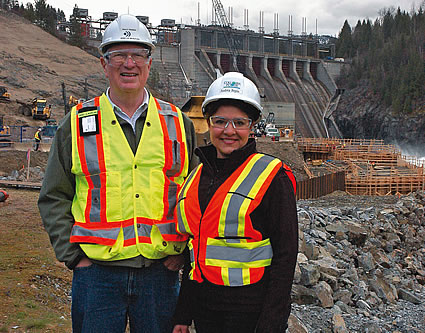A legacy for the Basin
The construction of a second power plant on the Waneta Dam will utilize water that would otherwise pass over the dam’s spillways

Wally Penner, the regional project manager for SNC-Lavalin, and Audrey Repin, the spokesperson for the Waneta expansion Project and the director of stakeholder relations for Columbia Power, oversee every facet of the Expansion. — Tanya Laing Gahr photo
Electricity is one of those things that we in B.C. tend to take for granted—until it goes out—especially with the renewable energy generated in-province at various hydroelectric dams. It’s touted as green energy because it doesn’t require the burning of fossil fuels. These projects are required for the continued growth of B.C.
However, the demand for electricity within B.C. is growing and many of the facilities in place since the late 1960s are in need of serious upgrading. In the last decade and a half, many of the hydroelectric dams in the Kootenay region have seen significant improvements—including the Arrow Lakes Generating Station at the site of the Hugh Keenleyside Dam (1999) and Brilliant Dam (2008), both in the Castlegar district; BC Hydro's Aberfeldie Dam near Cranbrook (2009); and the Revelstoke Dam (2009). While these massive projects help meet the demand for electricity, they have several other immediate and long-term benefits—including the chance to right some historical wrongs.
Let’s face it—mid-century dam construction in B.C. wasn’t always done with due care and consideration for the environment, for aboriginal rights or for landowners affected by changing water levels. The dams were a necessary evil, to be sure, but the way some of the negotiations and construction processes were handled left a bad taste in the mouth of many affected residents.
We've come a long way, baby
The Waneta expansion near Trail, B.C., is an example of how to do things right, and it’s producing a few watershed moments for people involved with the project, including Audrey Repin, Columbia Power Corporation’s director of stakeholder relations and communications and the official spokesperson for the Waneta expansion.
“I’m so, so proud of this project,” said Repin.
Columbia Power Corporation is in partnership with the Columbia Basin Trust and Fortis Inc. on the $900-million undertaking, which includes the construction of a 335-megawatt powerhouse directly downstream from the Waneta Dam near the confluence of the Pend d’Orielle and Columbia rivers.
The project has a number of facets. Two parallel tunnels that will carve through bedrock to connect the approach channel above the existing Waneta Dam (jointly owned by Teck Resources Inc. and BC Hydro) are currently under construction. The water from these tunnels will feed into two turbines in the powerhouse below the dam. (Currently, the water that will enter the approach tunnel is spillwater over the existing dam.) Additionally, a 10-kilometre transmission line will be built to parallel the existing high-voltage transmission line owned by BC Hydro that extends from the site to the Selkirk substation.
Once completed, the operation will be run by Fortis BC, which will sell the power to BC Hydro and Fortis Inc. When it is operational, the Waneta Dam is expected to reduce greenhouse gas emissions by approximately 400,000 CO2 equivalent tonnes per year.
Residents of the Basin benefit
The Waneta Expansion Project has an estimated 4.5-year duration period and will create more than 400 jobs for residents of the area, which will equal an estimated $200 million in paid wages and benefits as well as an estimated $178 million in local spending for goods and services. Repin said that the Waneta Expansion Project is utilizing a collective agreement that was put in place when the Columbia River Treaty Dams were being built in the 1960s. Simply stated, the agreement said that the local community will also benefit from the expansion by utilizing local hire.
“Various unions are signatory to the Allied Hydro Council,” said Repin. “That means when a contractor needs a particular skill . . . there is an obligation to look at local hire first. This means people living within 100 kilometres of the project get the opportunity first. You can imagine what that does to help the local economy and right now, (the Waneta expansion) is looking at 85 per cent local hire.”
A tightly choreographed dance
A high bar has been set as far as safety is concerned on the project. SNC-Lavalin, the prime project contractor for the Waneta expansion, will be overseeing safety on site from the beginning to the end of the project.
Wally Penner, the regional project manager for SNC-Lavalin, said that every possible safety precaution is not only being met, but exceeded. In fact, an independent auditor who came to the Waneta expansion construction site indicated that SNC-Lavalin, ASL Joint Venture and its subcontractors are 93 per cent compliant with optimal work site safety.
“There are inherent dangers on a construction site,” said Penner. “So we do safety orientation for all workers. No workers can go on site without safety indoctrination and, of course, we train people and have safety people on site at all times. We tell people that safety is number 1 and we don’t take chances . . . (Proof) is always in the results—we have well over 100,000 man hours logged and we haven’t had a time-lost accident yet.”
Protecting those with no voice
As much as safety is key to the Waneta expansion, environmental consciousness is being taken just as seriously. For starters, Penner said there are two water treatment plants on site. Before water is put back into the river, it is treated so that it is in the same state as if it were fresh water. In addition, sturgeon, which are an endangered species, spawn at the confluence of the Columbia River and the Pend d’Orielle River. Repin said that even before getting approval for the Waneta expansion, they had to prove that construction would not affect the sturgeon’s critical breeding grounds.
Also, the region where construction has commenced is home to rubber boas. These creatures resemble a giant earthworm but are considered one of the most docile in the boa family. They also enjoy lying in warm places and find the hot highway pavement especially comfortable. To reduce as many snake fatalities as possible, SNC-Lavalin has placed Snake Crossing signs on the highway and is encouraging people to slow down on the road. Finally, Penner said SNC-Lavalin is already working to restore plant habitat.
“Once we finish on the slopes we seed them right away,” said Penner. “It keeps down dust and creates vegetation early on in the project. We don’t wait until the end of the project—when we leave the project it should all be vegetated.”
A community endeavour
Repin acknowledges that the Waneta expansion will affect many residents of the Kootenay Boundary region and beyond. To keep community members and interested parties in the loop, a community impact management committee has been formed. It comprises local stakeholders, including representatives from Fortis BC, Columbia Power, Columbia Basin Trust, SNC-Lavalin, the Ktunaxa Nation Council, the RCMP and the regional district. Repin said that she generally meets every day with various organizations to make sure that their voices are heard. There are also a series of presentations that are offered in the evenings to those interested in what is happening with the Waneta expansion.
“You are always working with the community and it takes a lot of work,” said Repin. “But in the end it is worth it because the community knows that it is their project too and they feel like a part of it—that is where my pride personally rests.”





Comments